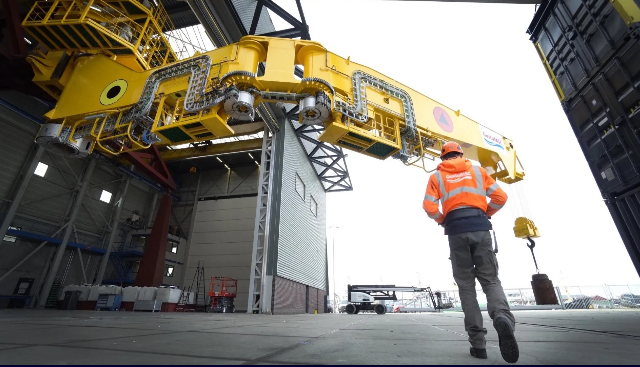Increased offshore productivity and safety thanks to an innovative crane.
 Consumption and Production
Consumption and Production
As an operator on an offshore drilling platform, safety and efficiency are paramount. GustoMSC designed an electrically powered crane with two pivot points in the boom, resulting in a wide working range. System integrator Batenburg JB Systems and Siemens handled the electrical and control aspects. This innovation leads to increased productivity, safety, and sustainability.
Would you like more information?
Kees van der Meijden
Sales Manager
In the offshore industry, materials and personnel are highly valuable, and even a slight time-saving on a project can result in significant cost savings. Therefore, the client, Maersk Drilling (an offshore drilling operator), sought an efficient and safe solution for equipment movement on an offshore drilling platform. To maximize productivity, they desired the crane to be usable during drilling operations as well. The challenge was to design a crane capable of reaching all areas beneath the cantilever (the extendable platform supporting the drilling tower). Engineers at GustoMSC addressed this by incorporating hinge points in the crane's boom. With dual hinges, the crane moves similar to a crab's leg, earning it the name "Chela," the English term for a crab's pincer.
Highest safety
Spyros Magripis, formerly an engineer at GustoMSC and now the product owner of the Chela series, played a key role in its development. Safety is the top priority in the offshore industry, which required the crane to meet the highest standards. "The dual certification was particularly challenging," said Magripis. "The crane had to comply with both DNV and NORSOK requirements. We implemented redundancy throughout to prevent safety incidents and ensure backup capabilities during malfunctions."
GustoMSC focused primarily on the mechanical aspects and specifications of the Chela crane. For the control and electrical components, they engaged system integrator Batenburg JB Systems. Magripis explained, "At GustoMSC, we preferred using Siemens technology for the crane. Siemens is well-regarded, and their hardware and software are trusted in the offshore industry. Thus, we sought a partner with Siemens expertise for control and electrical engineering. Batenburg JB Systems from Vlaardingen was our choice. They are a Siemens drives & motion partner, have extensive offshore experience, and can adapt quickly and flexibly. Additionally, their proximity to our headquarters in Schiedam facilitated collaboration." The crane incorporates PLCs, HMIs, safety systems, and drives from Siemens, among other elements.
The crane is entirely electrically powered instead of hydraulic, making it quieter, cleaner, and more energy-efficient.
Spyros Magripis, Product Owner of the Chela series at GustoMSC.
Simulation
For Batenburg JB Systems, the main challenge was the short lead time. "GustoMSC had already been working on the Chela when we joined," says Cor Blok, sales engineer at Batenburg JB Systems. "Simulation helped us make rapid progress. We transformed the 3D CAD model of the Chela into a simulator to demonstrate how the crane would operate and move. The simulator is also used for operator training."

Thanks to the increased range of the crane, materials can be easily and safely transported. The drilling tower no longer needs to be shut down for material movement, resulting in a productivity gain of up to 10%.
Complexity
"Mechanically, this is a unique crane," Blok continues. "It moves like a crab, and integrating the cable carriers was complex. During the project, it was decided that the Chela should have even more movements than initially planned, requiring additional motors and cabling. Moreover, everything had to be explosion-proof, which added further complexity." The double hinge point may also cause confusion for the operator while operating the crane. Blok says, "We made the controls as intuitive as possible by marking crane parts with symbols derived from game controllers. This way, the operator quickly grasps how the crane moves, regardless of their position on the platform."

"De S120 drives bevatten zeer veel parameters. Hierdoor zijn de mogelijkheden eindeloos, maar je moet wel weten wat je doet."
Specialist Work
Despite the complexity, the electrical engineering and software development took less than a year. Blok says, "This is our strong point: we can create highly complex solutions in a short time. Our experience with Siemens' portfolio plays a significant role here. We have frequently applied the modular SINAMICS S120 drive system in both production machinery and offshore installations. Siemens assisted us in making detailed choices, such as determining the required number of control units. In the TIA Portal, we programmed PLCs, safety features, HMI, and the connection with the drive system. Convenient and efficient." Magripis adds, "This is specialist work. Siemens' S120 drives have numerous parameters, providing endless possibilities, but you must know what you're doing. We don't have that expertise in-house, so we were fortunate that Batenburg JB Systems could assist us."
Safe, sustainable, and efficient
Operators working with the Chela are impressed. Magripis says, "They feel very safe. Thanks to the increased range under the cantilever, materials can be easily and safely transported. The drilling tower no longer needs to be shut down for material movement, resulting in a productivity gain of up to 10%. This shortens project lead times and reduces costs. Moreover, the crane is entirely electrically powered instead of hydraulic, making it quieter, cleaner, and more energy-efficient. For maximum versatility, the crane can be quickly disassembled and moved to the next location."
Saving costs and reducing polluting helicopter flights
The Chela perfectly fits GustoMSC's portfolio of mobile offshore installations and equipment, enabling safe and efficient projects at sea. In the offshore industry, digitalization is gaining traction. Magripis explains, "Security used to be a major concern in digitalization, but over the past two years, there's been growing trust. Customers increasingly see the benefits of digitalization, such as predictive maintenance or cloud-based data analysis. Remote support is particularly crucial. Downtime of installations at sea costs a fortune. Thanks to remote support, service engineers are needed less frequently, saving a lot of money and reducing polluting helicopter flights." Blok adds, "We also applied digitalization to the Chela. Machine data is accessible for preventive maintenance and diagnosis, including operating hours, alarms, and faults. We can also dial into the installation from any location (remote access) to provide support from a distance."
Curious how the Chela works? Check out the video.
